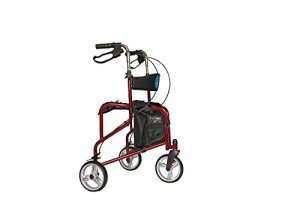
Compact Rollator
متابعةنظرة عامة
-
القطاعات الاعمال و الإدارة-المسائل المالية
-
تم نشر الوظائف 0
-
المشاهدة 9
وصف الشركة
Ergonomic Rollator Techniques To Simplify Your Everyday Lifethe Only Ergonomic Rollator Technique Every Person Needs To Know
Understanding Ergonomic Rollators: A Comprehensive Guide
As the population ages, the requirement for mobility aids becomes progressively essential. Among these aids, the rollator has actually gained appeal for its convenience and support. However, not all rollators are created equal. Go into the ergonomic rollator, a specifically developed device focused on boosting user comfort and mobility. This short article looks into the features, benefits, and factors to consider of ergonomic rollators while supplying insights into their growing significance in senior health and health.
What is an Ergonomic Rollator?
An ergonomic rollator is a mobility aid created to support individuals who may have trouble walking or maintaining balance. Unlike conventional walkers, rollators come geared up with wheels and brakes, enabling a smooth transition through different terrains. The ergonomic design concentrates on lowering strain on the user’s body, making it a perfect option for those with arthritis, joint issues, or recovery from surgery.

Secret Features of Ergonomic Rollators
| Function | Description |
|---|---|
| Adjustable Handlebars | These can be personalized to fit the user’s height, guaranteeing optimal posture and minimizing back strain. |
| Lightweight Frame | Numerous ergonomic rollators are made from lightweight products, enabling for simple maneuverability. |
| Comfortable Seat | A padded seat supplies an area for users to rest when needed, promoting longer use without fatigue. |
| Easy-to-Use Brakes | The brakes are uncomplicated to run, improving safety throughout use. |
| Foldable Design | Perfect for transportation and storage, ergonomic rollators can be easily folded when not in use. |
| Storage Options | Many models come geared up with baskets or pouches, supplying included convenience for carrying individual items. |
Benefits of Using an Ergonomic Rollator
The ergonomic rollator is designed with user performance in mind. Here are some of the main benefits that make it a favorable choice:
-
Enhanced Stability and Support: The structure of ergonomic rollators enables much better balance, empowering users to move confidently.
-
Lowered Physical Strain: With adjustable features and assistance for better posture, users can experience less fatigue and discomfort.
-
Increased Independence: By utilizing an ergonomic rollator, numerous individuals regain the capability to perform daily activities without depending on assistance.
-
Flexible Usage: Ergonomic rollators can be utilized both inside your home and outdoors, offering seamless mobility across different environments.
-
Promotes Active Living: Encouraging users to stay active is crucial for total health; rollators offer the assistance required to explore safely.
Frequently Asked Questions About Ergonomic Rollators
What should I look for when acquiring an ergonomic rollator?
- Consider the weight capacity and measurements to ensure it is ideal for your requirements.
- Look for features like adjustable handlebars and brakes for customized convenience.
- Search for good reviews and think about designs with warranties for quality control.
Are ergonomic rollators suitable for outdoor use?
- Yes, many ergonomic rollators are developed with robust wheels and frames, making them perfect for different surfaces, consisting of pathways and parks.
How do I maintain my ergonomic rollator?
- Regularly inspect the brakes, wheels, and frame for wear.
- Tidy the rollator with a wet cloth; avoid severe chemicals that can harm its finish.
Can I use my ergonomic rollator for travel?
- Absolutely! Lots of ergonomic rollators are developed to be lightweight and foldable, making them easy to transportation and store.
Will my insurance cover the cost of an ergonomic rollator?
- Coverage may vary based upon your insurance coverage strategy. It is necessary to check with your provider for particular policies regarding mobility aids.
Factors to consider When Choosing an Ergonomic Rollator
When picking an ergonomic rollator, a number of essential aspects should be considered:
- Weight and Portability: Ensure the rollator is simple to raise and carry.
- Height Adjustability: Features ought to allow for easy height adjustments based upon user convenience.
- Wheel Size: Larger wheels are much better for outdoor use, while smaller sized wheels are often adequate for indoor environments.
- Storage Capacity: Look for rollators with extra storage choices if carrying products is required.
- Construct Quality: Select a rollator made from durable products that can hold up against day-to-day wear and tear.
Tips for Safe Use of an Ergonomic Rollator
Utilizing an ergonomic rollator safely is important for avoiding mishaps and guaranteeing a smooth mobility experience. Here are some practical ideas:
- Proper Setup: Adjust the handlebars to hip level before use for optimum posture.
- Inspect Brakes Before Use: Always make sure the brakes are operating properly before moving.
- Navigate Surfaces Carefully: Be mindful on uneven or slippery surface areas, as stability can differ.
- Use the Seat When Needed: If feeling fatigued, make use of the built-in seat for a rest before continuing your journey.
- Practice Turning: When turning, ensure to pivot instead of pulling the rollator along, which can result in imbalance.
Ergonomic rollators represent a substantial development in mobility aids, catering specifically to the needs of those who need additional assistance while keeping self-reliance. By understanding the features, benefits, and appropriate use of ergonomic rollators, users can boost their mobility, improve their lifestyle, and continue to engage with their surroundings with confidence. As the demand for reliable mobility services continues to grow, ergonomic rollators stick out as exemplary tools for promoting better health and mobility in senior residents and people with mobility challenges.
